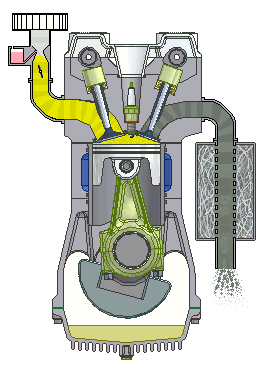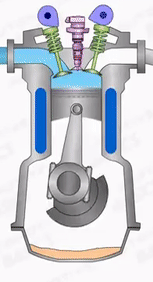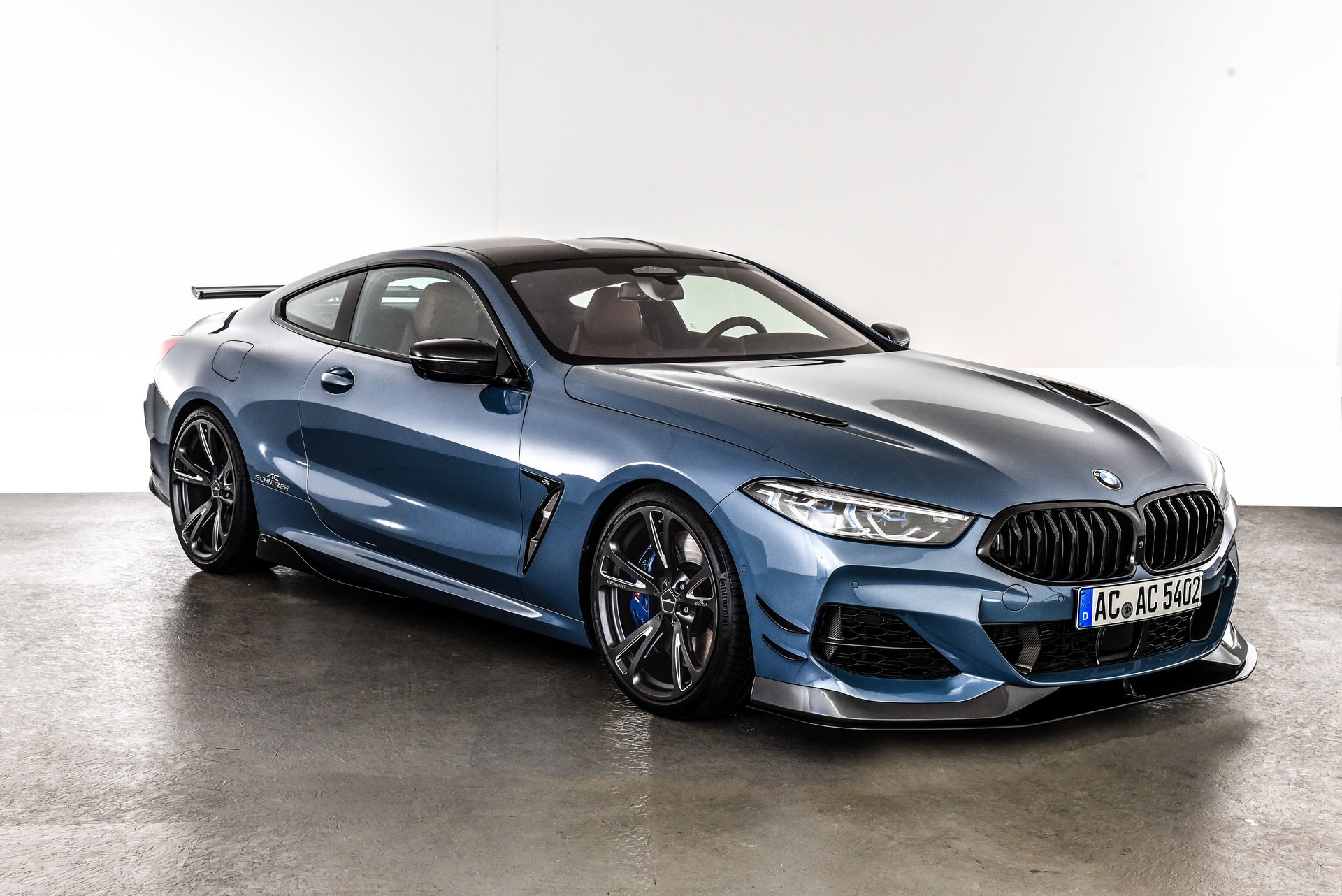Petrol Engine v/s Diesel Engine
Today in this article, we are going to discuss the major points of differences between, a petrol engine and a diesel engine, and their characteristics which make them suited for different purposes.
Before discussing the differences between the construction of the two engines, let's begin with differentiating the fuel driving them.
Petrol

Petrol is a highly volatile fuel consisting mostly of the organic compounds, which is the end result of fractional distillation of petroleum. It is blended with additives, so as to enhance the quality of the fuel and increasing its performance characteristics, anti-corrosive nature, chemical stability, and also acts as a cleaning agent that keeps the fuel system clean and in good health. Petrol and air mixture inside the engine, requires an agent to ignite itself, that is, a "spark". Petrol may contain oxygen compounds, like Ethanol, to increase its combustibility.
Petrol is also offered in various grades, usually called Octanes, which delays the ignition of the fuel to enhance the performance of the engines. Contrary to this, if air and fuel mixtures are ignited early, it would cause loss of performance, and problems like, knocking in the engine, thus causing engines to lose their efficiency in the long run.
What could be inferred from the above information is, that petrol is highly volatile in nature and needs an agent for its ignition, that is, a sparking mechanism.
Diesel

Diesel is a non volatile derivative of petroleum, that does not require a spark to ignite itself. Instead, diesel gets self ignited inside the cylinder of the engine due to increased compression of the air inside the cylinder. Huge compression of air mixture inside the cylinder makes the temperature of air ample enough to ignite the diesel injected directly into the chamber, thus making pistons work. What differs the diesel engines from its petrol counterparts, is its higher compression ratios, which ignites the fuel naturally without using a specific mechanism for its ignition, though a fuel injector is used to inject diesel directly into the cylinders.
Challenges faced in Cold weathers
Diesel is a viscous fuel, whose viscosity increases with a decrease in temperature, thus it becomes difficult for the diesel engines to start in cold weathers, because the diesel in the cold tank has already been turned into a jelly like substance, which makes it immobile through the fuel injector units. To counter this, diesel engines are provided with thermostats, and grid heaters which preheats the cylinders to a minimum operating temperatures, which helps in igniting the diesel initially to start up the engine.
Where the difference comes
Petrol Engines, are specially designed to burn petrol mixture to produce power. The construction of the petrol engines are in accordance with the combustible nature of the volatile fuel. Petrol engines have lower compression ratios than diesel engines. The reason behind the lower compression ratios of petrol engines, is to prevent the auto-ignition of air and petrol mixture inside the combustion chamber.
If petrol engines featured higher compression ratios as of diesel engines, the air and fuel mixture would have self ignited too early, leading to improper combustion which would have caused reduction in efficiency, knocking in the engines, in few cases, may have caused an engine failure.
In extreme cases, may result into a burnt up engine under the hood.
Therefore, Petrol engines are designed specifically for the type of fuel they use.

The level of sophistication in the building up of an engine is such that, their ignition mechanism is engineered with quite a lot of expertise. In case of petrol engines, the spark plugs are employed, in order to ignite the fuel mixture in a timely and efficient manner. The way, the spark plugs achieve this efficiency, is by timing the rotations of the engine crankshaft, with the help of timing belt, linking the camshaft, which would ensure that spark plug only functions at that very particular compression stroke when the air and fuel mixture is inside the combustion chamber. If engine is at slower speeds, the sparking would take place at a slower rate, if engine is at higher speeds, the sparking would take place at a relatively higher rate, with the purpose being solely to synchronize the spark plug with the engine strokes.
In petrol engines, the mixing of air and fuel takes place in the carburetor, now in modern day petrol engines, mixing takes place in the ECU controlled fuel injectors, after which the mixture formed makes its way to the combustion chamber to ignite itself by the sparkplug.
Diesel engines ignite the fuel without prior mixing with the air. In essence, the fuel injectors inject the fuel directly into the combustion chamber, and the mixing takes place there itself, and due to higher temperatures of the air inside the chamber during the compression stroke, the diesel mixture gets self-ignited. Also to perfectly time the fuel injection into the combustion chamber, timing belt is used to synchronize the timings of the compression stroke and the injection of fuel into the cylinders.

Petrol engines have higher rotations speeds than diesel engines, due to their lower compression ratios, a lighter pistons and crankshaft arrangement, and also due to petrol burning quickly than the diesel.
Because of the above internal factors, each engine carries a different characteristics. Petrol engine aids for more power, but due to shorter strokes, it is less efficient, resulting into lesser fuel efficiency. Petrol engine finds its way into lighter transport facility, light motor vehicles, bikes, and scooters, where the load bearing capacity is on the lighter side.
Diesel engine due to its greater compression ratios, produces more torque, that is, the pulling power of the engine, and is more efficient due to its longer strokes, hence increasing fuel efficiency. Diesel engine find its way into heavy transport facility, heavy duty vehicles, where the load bearing capacity of the vehicle is on the heavier side, which would require a heavy duty engine to work for it.
Tuning of Engines
The above discussed are the default characteristics of both the engines. But both the engines can be specifically tuned to achieve a mix of power and torque suiting with the vehicle being used in.
For instance, a petrol engine can also produce more torque than power, consecutively, diesel engines can also produce more horsepower, entirely depending upon the tuning of the engines.
Royal Enfield having an engine capacity of 350cc, produces a peak power of 20.4 Bhp and a peak torque of 28 Nm. Being a cruiser, the petrol engine is tuned to produce more torque than horsepower, to enhance the pulling power of the vehicle despite of being relatively heavier, as well as in aiding for better cruising speeds on highway and in cities, without having to change gears frequently.
Whereas the Apache RR 310 having an engine capacity of 312 cc, produces a peak power of 33.5 Bhp and a peak torque of 27.3 Nm. Being a sports tourer, the engine has been tuned to produce more horsepower to let the vehicle reach higher speeds and comparatively in much shorter time.
Let's repeat the scenario with the Diesel engines,
Tata trucks having an engine capacity of 6000cc, produces peak power output of 175 Bhp and a peak torque output of 700 Nm, it is obvious for a vehicle of this size and weight to have more on torque than horsepower. Also the vehicle is solely used for heavy transport facility.
For BMW, to produce this level of torque output, and a horsepower figures much greater than this, it would require only 3000cc of diesel engine, which produces peak power output of 335 Bhp, and 700 Nm of torque, that is half the capacity of the one used in trucks, and near to double, the performance offered.
But at some cost,
The cost of maintenance of Tata engines would be comparatively much lower than the cost of maintenance of BMW's diesel engines.
Choosing between the Two
In modern day world, for a vehicle to be equipped with either a petrol or a diesel engine, is entirely dependent upon what performance, and mileage, its user is expecting from the vehicle. For a punchy performance in lower and mid range along with better fuel efficiency, diesel engines are being used for the purpose, while for the users who like to redline to use every bit of power, petrol engines serve them better, For a light motor vehicle, it is impractical to offer diesel engine. Despite having lesser weight and nearly no practical implication of the diesel engine.
In long run, petrol engines are more economical than diesel engines, because of its lower maintenance cost, petrol having a natural cleaning property keeps the engine cleaner from inside, thus giving long life to the engines, also having lesser complexity in the moving parts of the engine as compared to the diesel counterpart. The diesel engine compensates the above factors, by providing a punchy driving experience, and may also prove to be a valuable proposition if the purpose is well thought of.
Verdict
"The objective of this article is not to discourage anyone from buying vehicles with diesel engines, but to let consumers have a clear vision of the purpose, for which the vehicle is going to be used, in accordance to which, a suitable engine should be opted by the consumer, and take a well informed decision."



Comments
Post a Comment